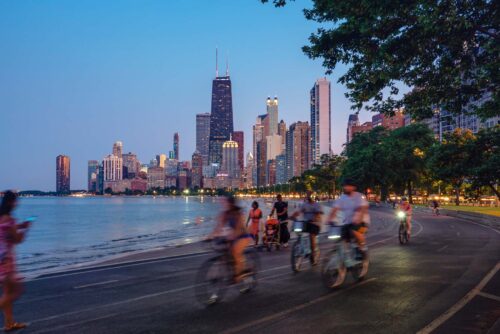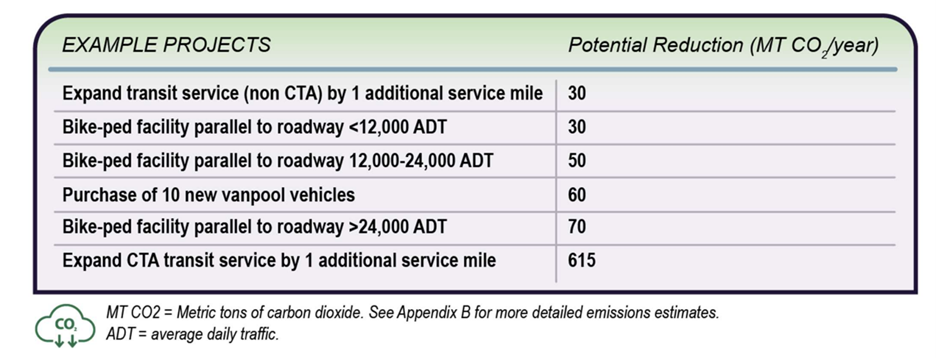
Analysis: Illinois is leaving money on the table until it embraces clean transportation
Clean transportation choices would unlock $2,800 per household each year — while saving thousands of lives.
New analysis from RMI finds that Illinois households could save over $2,800 dollars per year in direct cost savings from three strategies to expand transportation choices across the state. In addition to cost savings, investments in vehicle electrification and driving alternatives would slash climate pollution, leading to cleaner air and saving thousands of lives from improved health and vehicle safety outcomes.
We analyzed three strategies:
- Vehicle Electrification Standards, including Advanced Clean Cars II (ACCII) and Advanced Clean Trucks (ACT), which increase the sale of electric cars and trucks
- Climate-driven Agency Planning, where agencies take climate targets into account when considering infrastructure projects
- Renewed Investments in State Transit Systems, where states increase funding for transit
These strategies are considered best practice from peer states. 12 states have adopted Advanced Clean Cars II and/or Advanced Clean Trucks to promote zero-emissions vehicle adoption. Peer states like Minnesota, Colorado, and Virginia have updated agency project scoring to systematically consider land use and climate impacts of infrastructure projects. While Illinois faces a looming transit fiscal cliff, California, New York, and Minnesota have committed billions of new dollars in transit funding to spur economic growth and ensure their commuters have affordable choices to get to work.
Cost savings from clean transportation
Previous RMI analysis finds that Illinois is not on track to meet national climate goals, largely due to increasing transportation pollution, the primary source of emissions in the state. Using several RMI tools (assumptions here), we found that embracing the trio of clean transportation strategies in Illinois could slash pollution by up to 305 million metric tons between 2024 and 2050 — equivalent to the emissions avoided by running 3,000 new wind turbines during the same time period.
It turns out that a cleaner, more efficient transportation system is also more affordable than a grid-locked one. Due to the reduced maintenance and fueling costs of electric vehicles, commuters can expect to save an average of $732 per year by ditching gas guzzlers with Advanced Clean Cars II.
These savings leap to $2,815 if the state also promotes system design that brings everyday destinations closer together and boosts the convenience of transit and other multimodal choices, such as biking and walking. In addition to more operating savings, shorter and avoided car trips help combat congestion, saving each driver about twenty-seven hours of traffic time per year, while also slowing depreciation, helping Illinoisians preserve the value of their vehicle when it’s time to trade in or downsize family cars.
Better health and well-being benefits
While cost savings are exciting, the human toll of an inefficient transportation system cannot be discounted. The three clean transportation strategies in combination would save thousands of lives from Chicago to Springfield.
The largest source of direct mortality prevention would be from reduced crash fatalities — Illinois could expect 220 more loved ones to make it home each year, given that car alternatives are orders of magnitude safer than car travel.
Pollution from the current transportation system also contributes to fatalities. Children, seniors, and people of color are most likely to die from respiratory complications, according to the American Lung Association (ALA). Our analysis finds that the electrification of vehicles would drive air quality improvements that on average save 47 lives per year in the Prairie State, primarily in vulnerable communities that cannot escape the air pollution they’re exposed to. ALA concurs and independently finds that ACCII/ACT-style policy would prevent 138,000 asthma attacks in Illinois by 2050.
It is also worth discussing the life-extending health benefits of active transportation alternatives. If residents could replace just 1 in 25 of their car trips with a brisk bike ride or walk, our analysis projects that 1,645 premature deaths would be avoided each year in Illinois. This finding was informed by a recent Harvard Public Health-led investigation, which shows that even modest increases in physical activity contribute to significantly improved mortality outcomes.
The health benefits are not just long-term; active transportation can increase wellness on a day-to-day basis. Imagine dropping your kids off at school in a cargo e-bike or being able to walk to get groceries — the impacts of fresh air, heightened endorphins, and increased vitamin D is enough to leave anyone happier, healthier, and in better shape.
Abundance of federal resources ideal for state investment
Thanks to the availability of federal funding, there’s never been a better time for Illinois to unlock the benefits of clean transportation. Illinois was awarded $225 million in federal funding from the Bipartisan Infrastructure Law to develop climate-smart transportation strategies and has received millions more from the Inflation Reduction Act to purchase hundreds of electric school buses.
Exhibit 3: This table from the Illinois Department of Transportation shows the impact of potential strategies to expand clean and affordable transport choices, which the state can fund with $225 million from the Bipartisan Infrastructure Law.
However, more state actions are needed to maximize the uptake of these federal dollars to preserve the fiscal and environmental health of state transportation systems. Illinois has yet to adopt clean vehicle standards, even as the state receives $149 million to build out its charger network. The transit system is aging, with 30% of vehicles past their useful life. The state DOT acknowledges that increasing dependency on car-centric infrastructure may have negative impacts on equity and climate, but has yet to consider these metrics in its project scoring.
Illinois decision makers have the power to create a life of less traffic, cleaner air, and better health for their constituents now — and the above strategies will secure the most equitable and cost-efficient outcomes along the way.
This work was supported by Bloomberg Philanthropies and Sustainable Cities Fund
